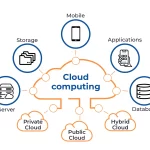What is the history of cloud computing
/ /
Cloud computing has become an integral part of our digital landscape, transforming the way we store, access, and manage data. But how did this revolutionary technology come into existence? In this blog post, we will embark on a journey through the history of cloud computing, tracing its origins, key milestones, and the advancements that have led to its widespread adoption.
- Early Roots: The concept of cloud computing can be traced back to the 1960s when computer scientist John McCarthy first proposed the idea of “utility computing.” His vision was to make computing power and resources available to users as easily as electricity is accessed from the power grid. This notion laid the groundwork for the development of cloud computing.
- The Emergence of Virtualization: The advent of virtualization technology in the late 1990s and early 2000s played a pivotal role in shaping cloud computing. Virtualization enabled the creation of multiple virtual machines (VMs) on a single physical server, allowing for efficient resource utilization and isolation. This breakthrough technology provided the foundation for the scalability and flexibility that would later define cloud computing.
- Web Services and Grid Computing: The late 1990s and early 2000s saw the emergence of web services and grid computing, which further contributed to the evolution of cloud computing. Web services allowed for the delivery of software and applications over the internet, while grid computing focused on distributing computing tasks across multiple machines to solve complex problems. These technologies paved the way for the distributed and interconnected nature of cloud computing.
- The Birth of Cloud Computing: The term “cloud computing” was coined in the early 2000s, and its definition started taking shape. Amazon Web Services (AWS) played a significant role in popularizing cloud computing with the launch of Amazon Elastic Compute Cloud (EC2) in 2006. This service provided scalable virtual servers in the cloud, allowing users to rent computing power on-demand. This marked a major shift in the IT industry, sparking the era of cloud computing.
- Expansion and Market Dominance: Following the success of AWS, other tech giants like Microsoft, Google, and IBM entered the cloud computing market, offering their respective cloud platforms. Microsoft Azure, Google Cloud Platform, and IBM Cloud expanded the availability and capabilities of cloud services, leading to increased adoption across various industries. The competition among these providers further accelerated innovation and drove down costs, making cloud computing accessible to businesses of all sizes.
- Advancements and Current Landscape: Cloud computing has witnessed significant advancements in recent years. The introduction of containerization technologies, such as Docker, has improved resource efficiency and application deployment. Serverless computing, represented by services like AWS Lambda and Google Cloud Functions, allows developers to focus solely on writing code without worrying about infrastructure management. Additionally, edge computing has emerged to process data closer to its source, reducing latency and enabling real-time applications.
Posted in Blogs


































